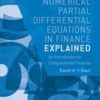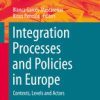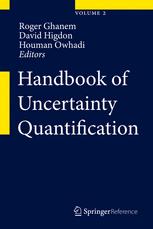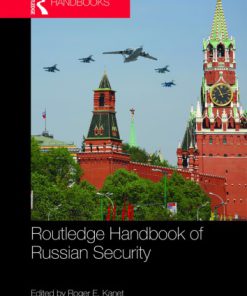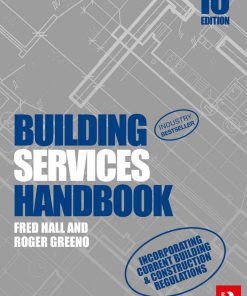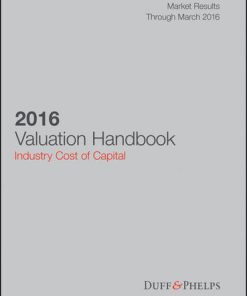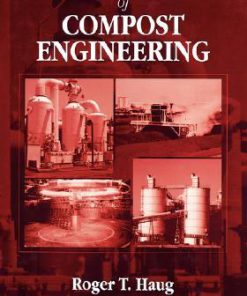Handbook of Quantile Regression 1st Edition by Roger Koenker ISBN 1351646567 9781351646567
$50.00 Original price was: $50.00.$25.00Current price is: $25.00.
Handbook of Quantile Regression 1st Edition by Roger Koenker – Ebook PDF Instant Download/Delivery: 1351646567, 9781351646567
Full download Handbook of Quantile Regression 1st Edition after payment
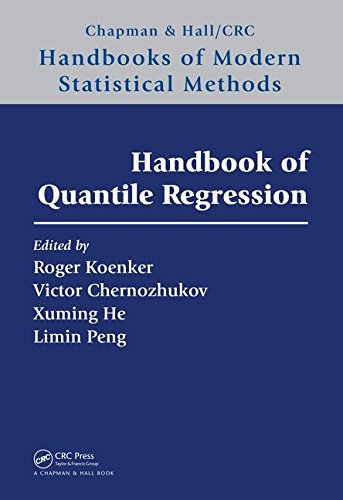
Product details:
ISBN 10: 1351646567
ISBN 13: 9781351646567
Author: Roger Koenker
Quantile regression constitutes an ensemble of statistical techniques intended to estimate and draw inferences about conditional quantile functions. Median regression, as introduced in the 18th century by Boscovich and Laplace, is a special case. In contrast to conventional mean regression that minimizes sums of squared residuals, median regression minimizes sums of absolute residuals; quantile regression simply replaces symmetric absolute loss by asymmetric linear loss. Since its introduction in the 1970’s by Koenker and Bassett, quantile regression has been gradually extended to a wide variety of data analytic settings including time series, survival analysis, and longitudinal data. By focusing attention on local slices of the conditional distribution of response variables it is capable of providing a more complete, more nuanced view of heterogeneous covariate effects. Applications of quantile regression can now be found throughout the sciences, including astrophysics, chemistry, ecology, economics, finance, genomics, medicine, and meteorology. Software for quantile regression is now widely available in all the major statistical computing environments. The objective of this volume is to provide a comprehensive review of recent developments of quantile regression methodology illustrating its applicability in a wide range of scientific settings. The intended audience of the volume is researchers and graduate students across a diverse set of disciplines.
Handbook of Quantile Regression 1st Table of contents:
1. A Quantile Regression Memoir
1.1 Long ago …
2. Resampling Methods
2.1 Introduction
2.2 Paired bootstrap
2.3 Residual-based bootstrap
2.4 Generalized bootstrap
2.5 Estimating function bootstrap
2.6 Markov chain marginal bootstrap
2.7 Resampling methods for clustered data
2.8 Resampling methods for censored quantile regression
2.9 Bootstrap for post-model selection inference
3. Quantile Regression: Penalized
3.1 Penalized: how?
3.1.1 A probability path
3.1.2 Regularization of ill-posed problems
3.2 Penalized: what?
3.2.1 The finite differences of Whittaker and others
3.2.2 Functions and their derivatives
3.2.3 Quantile regression with smoothing splines
3.2.4 Quantile smoothing splines
3.2.5 Total-variation splines
3.3 Penalized: what else?
3.3.1 Tuning
3.3.2 Multiple covariates
3.3.3 Additive fits, confidence bandaids, and other phantasmagorias
4. Bayesian Quantile Regression
4.1 Introduction
4.2 Asymmetric Laplace likelihood
4.3 Empirical likelihood
4.4 Nonparametric and semiparametric likelihoods
4.4.1 Mixture-type likelihood
4.4.2 Approximate likelihood via quantile process
4.5 Discussion
5. Computational Methods for Quantile Regression
5.1 Introduction
5.2 Exterior point methods
5.3 Interior point methods
5.4 Preprocessing
5.5 First-order, proximal methods
5.5.1 Proximal operators and the Moreau envelope
5.5.2 Alternating direction method of multipliers
5.5.3 Proximal performance
6. Survival Analysis: A Quantile Perspective
6.1 Introduction
6.1.1 Notation
6.1.2 Censoring
6.2 Important models
6.2.1 Parametric models
6.2.2 Nonparametric estimators
6.2.2.1 Kaplan–Meier estimator
6.2.2.2 Nelson–Aalen estimator
6.2.3 Regression models
6.2.3.1 Cox proportional hazards model
6.2.3.2 Accelerated failure time model
6.2.3.3 Aalen additive hazard model
6.3 Quantile estimation based on censored data
6.3.1 Quantile estimation
6.3.2 Median and quantile regression
6.3.3 Discussion and miscellanea
7. Quantile Regression for Survival Analysis
7.1 Introduction
7.2 Quantile regression for randomly censored data
7.2.1 Random right censoring with C always known
7.2.2 Covariate-independent random right censoring
7.2.3 Standard random right censoring
7.2.3.1 Approaches based on the principle of self-consistency
7.2.3.2 Martingale-based approach
7.2.3.3 Locally weighted method
7.2.4 Variance estimation and other inference
7.2.4.1 Variance estimation
7.2.4.2 Second-stage inference
7.2.4.3 Model checking
7.3 Quantile regression in other survival settings
7.3.1 Known random left censoring and/or left truncation
7.3.2 Censored data with a survival cure fraction
7.4 An illustration of quantile regression for survival analysis
8. Survival Analysis with Competing Risks and Semi-competing Risks Data
8.1 Competing risks data
8.1.1 Introduction
8.1.2 Cumulative incidence quantile regression
8.1.3 Data analysis example
8.1.4 Marginal quantile regression
8.2 Semi-competing risks data
8.2.1 Introduction
8.2.2 Cumulative incidence quantile regression
8.2.3 Marginal quantile regression
8.3 Summary and open problems
9. Instrumental Variable Quantile Regression
9.1 Introduction
9.2 Model overview
9.2.1 The instrumental variable quantile regression model
9.2.2 Conditions for point identification
9.2.3 Discussion of the IVQR model
9.2.4 Examples
9.2.5 Comparison to other approaches
9.3 Basic estimation and inference approaches
9.3.1 Generalized methods of moments and related approaches
9.3.2 Inverse quantile regression
9.3.2.1 A useful interpretation of IQR as a GMM estimator.
9.3.3 Weak identification robust inference
9.3.4 Finite-sample inference
9.4 Advanced inference with high-dimensional X
9.4.1 Neyman orthogonal scores
9.4.2 Estimation and inference using orthogonal scores
9.5 Conclusion
10. Local Quantile Treatment Effects
10.1 Introduction
10.2 Framework, estimands and identification
10.2.1 Without covariates
10.2.2 In the presence of covariates: conditional LQTE
10.2.3 In the presence of covariates: unconditional LQTE
10.3 Estimation and inference
10.4 Extensions
10.4.1 Regression discontinuity design
10.4.2 Multi-valued and continuous instruments
10.4.3 Testing instrument validity
10.5 Comparison to the instrumental variable quantile regression model
10.6 Conclusion and open problems
11. Quantile Regression with Measurement Errors and Missing Data
11.1 Introduction
11.2 Quantile regression with measurement errors
11.2.1 Linear quantile regression with measurement errors
11.2.1.1 Semiparametric joint estimating equations
11.2.1.2 Other methods for linear quantile regression with measurement errors
11.2.2 Nonparametric and semiparametric quantile regression model with measurement errors
11.3 Quantile regression with missing data
11.3.1 Statistical methods handling missing covariates in quantile regression
11.3.1.1 Multiple imputation algorithm
11.3.1.2 Modified MI algorithms
11.3.1.3 EM algorithm
11.3.1.4 IPW algorithms
11.3.2 Statistical methods handling missing outcomes in quantile regression
11.3.2.1 Imputation approaches for missing outcomes
11.3.2.2 Statistical methods for longitudinal dropout
12. Multiple-Output Quantile Regression
12.1 Multivariate quantiles, and the ordering of
12.2 Directional approaches
12.2.1 Projection methods
12.2.1.1 Marginal (coordinatewise) quantiles
12.2.1.2 Quantile biplots
12.2.1.3 Directional quantile hyperplanes and contours
12.2.1.4 Relation to halfspace depth
12.2.2 Directional Koenker–Bassett methods
12.2.2.1 Location case (p=0)
12.2.2.2 (Nonparametric) regression case ()
12.3 Direct approaches
12.3.1 Spatial (geometric) quantile methods
12.3.1.1 A spatial check function
12.3.1.2 Linear spatial quantile regression
12.3.1.3 Nonparametric spatial quantile regression
12.3.2 Elliptical quantiles
12.3.2.1 Location case
12.3.2.2 Linear regression case
12.3.3 Depth-based quantiles
12.3.3.1 Halfspace depth quantiles
12.3.3.2 Monge–Kantorovich quantiles
12.4 Some other concepts, and applications
12.5 Conclusion
13. Sample Selection in Quantile Regression: A Survey
13.1 Introduction
13.2 Heckman’s parametric selection model
13.2.1 Two-step estimation in Gaussian models
13.3 A quantile generalization
13.3.1 A quantile selection model
13.3.2 Estimation
13.4 Identification
13.5 Other approaches
13.5.1 A likelihood approach
13.5.2 Control function approaches
13.5.3 Link to censoring corrections
13.6 Empirical illustration
13.7 Conclusion
14. Nonparametric Quantile Regression for Banach-Valued Response
14.1 Introduction
14.2 Regression quantiles in Banach spaces
14.3 Nonparametric estimation
14.4 Data analysis
14.4.1 Simulation
14.4.2 Tecator data
14.4.3 Pediatric airway data
14.4.4 Cigarette data
14.4.4.1 Regression of price curve on sales curve
14.5 Consistency
14.5.1 Additional mathematical details
14.6 Concluding remarks
15. High-Dimensional Quantile Regression
15.1 Introduction
15.2 Estimation of the conditional quantile function
15.2.1 Regularity conditions
15.2.2 -penalized quantile regression
15.2.3 Refitted quantile regression after selection
15.2.4 Group lasso for quantile regression models
15.2.5 Estimation of the conditional density
15.3 Confidence bands for the coefficient process
15.3.1 Construction of an orthogonal score function
15.3.2 Regularity conditions
15.3.3 Score function estimator
15.3.4 Double selection estimator
15.3.5 Confidence bands
15.3.6 Confidence bands via inverse statistics
16. Nonconvex Penalized Quantile Regression: A Review of Methods, Theory and Algorithms
16.1 Introduction
16.2 High-dimensional sparse linear quantile regression
16.2.1 Background on penalized high-dimensional regression and the choice of penalty function
16.2.2 Nonconvex penalized high-dimensional linear quantile regression
16.2.2.1 Overview
16.2.2.2 Oracle property of the nonconvex penalized quantile regression estimator
16.3 High-dimensional sparse semiparametric quantile regression
16.3.1 Overview
16.3.2 Nonconvex penalized partially linear additive quantile regression
16.3.3 Oracle properties
16.4 Computational aspects of nonconvex penalized quantile regression
16.4.1 Linear programming based algorithms (moderately large p)
16.4.2 New iterative coordinate descent algorithm (larger p)
16.5 Other related problems
16.5.1 Simultaneous estimation and variable selection at multiple quantiles
16.5.2 Two-stage analysis with quantile-adaptive screening
16.5.2.1 Background
16.5.2.2 Quantile-adaptive model-free nonlinear screening
16.6 Discussion
17. QAR and Quantile Time Series Analysis
17.1 Introduction
17.2 Quantile regression estimation of traditional time series models
17.2.1 Quantile regression estimation of the traditional AR model
17.2.2 Quantile regressions of other time series models with i.i.d. errors
17.2.3 Quantile regression estimation of ARMA models
17.2.4 Quantile regressions with serially correlated errors
17.3 Quantile regressions with ARCH/GARCH errors
17.4 Quantile regressions with heavy-tailed errors
17.5 Quantile regression for nonstationary time series
17.5.1 Quantile regression for trending time series
17.5.2 Unit-root quantile regressions
17.5.3 Quantile regression on cointegrated time series
17.6 The QAR process
17.6.1 The linear QAR process
17.6.2 Nonlinear QAR models
17.6.3 Quantile autoregression based on transformations
17.7 Other dynamic quantile models
17.8 Quantile spectral analysis
17.8.1 Quantile cross-covariances and quantile spectrum
17.8.2 Quantile periodograms
17.8.3 Relationship to quantile regression on harmonic regressors
17.8.4 Estimation of quantile spectral density
17.9 Quantile regression based forecasting
17.10 Conclusion
18. Extremal Quantile Regression
18.1 Introduction
18.2 Extreme quantile models
18.2.1 Pareto-type and regularly varying tails
18.2.2 Extremal quantile regression models
18.3 Estimation and inference methods
18.3.1 Sampling conditions
18.3.2 Univariave case: Marginal quantiles
18.3.2.1 Extreme order approximation
18.3.2.2 Intermediate order approximation
18.3.2.3 Estimation of
18.3.2.4 Estimation of
18.3.2.5 Computing quantiles of the limit extreme value distributions
18.3.2.6 Median bias correction and confidence intervals
18.3.2.7 Extrapolation estimator for very extremes
18.3.3 Multivariate case: Conditional quantiles
18.3.3.1 Extreme order approximation
18.3.3.2 Intermediate order approximation
18.3.3.3 Estimation of and
18.3.3.4 Estimation of
18.3.3.5 Computing quantiles of the limit extreme value distributions
18.3.3.6 Median bias correction and confidence intervals
18.3.3.7 Extrapolation estimator for very extremes
18.3.4 Extreme value versus normal inference
18.4 Empirical applications
18.4.1 Value-at-risk prediction
18.4.2 Contagion of financial risk
19. Quantile Regression Methods for Longitudinal Data
19.1 Introduction
19.2 Panel quantile regression model
19.3 Fixed effects estimation
19.3.1 FE-QR estimator
19.3.2 FE-SQR estimator
19.3.2.1 Bias correction: Analytical method
19.3.2.2 Bias correction: Jackknife
19.3.3 Alternative FE approaches
19.3.3.1 Shrinkage
19.3.3.2 Minimum distance
19.3.3.3 Two-step estimation of Canay (2011)
19.4 Correlated random effects
19.5 Extensions
19.5.1 Endogeneity
19.5.2 Censoring
19.5.3 Group-level treatments
19.5.4 Semiparametric QR for longitudinal data
19.6 Conclusion
20. Quantile Regression Applications in Finance
20.1 Introduction
20.2 Quantile regression in risk management
20.2.1 Value-at-risk
20.2.2 Expected shortfall
20.3 Upper quantile information and financial markets
20.4 Quantile regression and portfolio allocation
20.4.1 The mean-ES portfolio construction
20.4.2 The multi-quantile portfolio construction
20.5 Stochastic dominance and quantile regression
20.6 Quantile dependence
20.6.1 Directional predictability via the quantilogram
20.6.2 Causality in quantiles
20.7 Concluding remarks
21. Quantile Regression for Genetic and Genomic Applications
21.1 Introduction
21.2 Genetic applications
21.2.1 Background and definitions
21.2.2 Candidate gene association study of child BMI
21.2.3 GWAS of birthweight
21.2.4 Genetic association with a set of markers
21.3 Genomic and other -omic applications
21.3.1 Background
21.3.2 Genomic data pre-processing
21.3.3 Sample size determination in gene expression studies
21.3.4 Determination of chromosomal region aberrations
21.3.5 Robust estimation and outlier determination in genomics
21.3.6 Genomic analysis of set of genes
21.4 Conclusion
22. Quantile Regression Applications in Ecology and the Environmental Sciences
22.1 Introduction
22.2 Water quality trends over time
22.2.1 A single site within a watershed
22.2.2 Multiple sites within a watershed
22.2.3 Estimation with below-detection limit values in a single site within a watershed
22.2.4 Additional extensions possible for water quality and flow trend analyses
22.3 Herbaceous plant species diversity and atmospheric nitrogen deposition
22.3.1 Quantile regression estimates
22.3.2 Partial effects of nitrogen deposition and pH and critical loads
22.3.3 Additional possible refinements to the model
22.4 Discussion
People also search for Handbook of Quantile Regression 1st:
Tags:
Roger Koenker,Handbook,Quantile Regression
You may also like…
Mathematics
Handbook of Uncertainty Quantification 1st Edition Roger Ghanem (Ed.) David Higdon (Ed.)
Politics & Philosophy - Anthropology
Routledge Handbook of Russian Security 1st Edition by Roger E Kanet ISBN 0815396716 978-0815396710
Engineering - Civil & Structural Engineering
Building Services Handbook: 10th edition Fred Hall & Roger Greeno
Business & Economics - Personal Finance
2016 valuation handbook: industry cost of capital 1st Edition Roger J. Grabowski
Business & Economics - Personal Finance
2016 international valuation handbook: a guide to cost of capital 1st Edition Roger J. Grabowski
Engineering
Handbook of Wood Chemistry and Wood Composites 2nd Edition by Roger Rowell 0367373025 9780367373023
Business & Economics - Personal Finance


